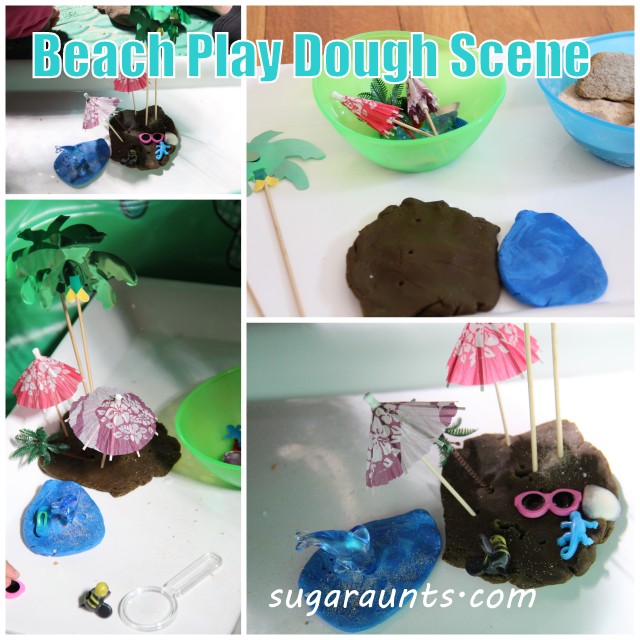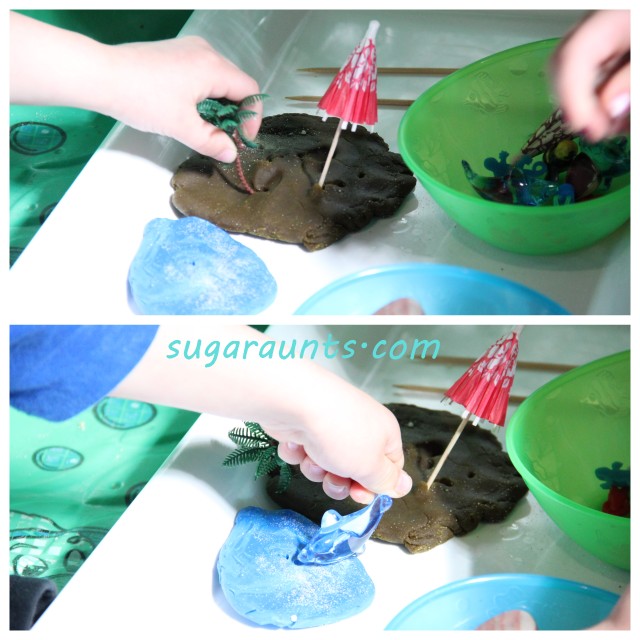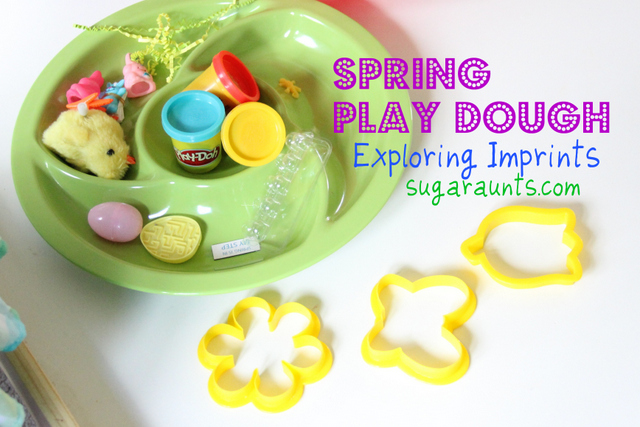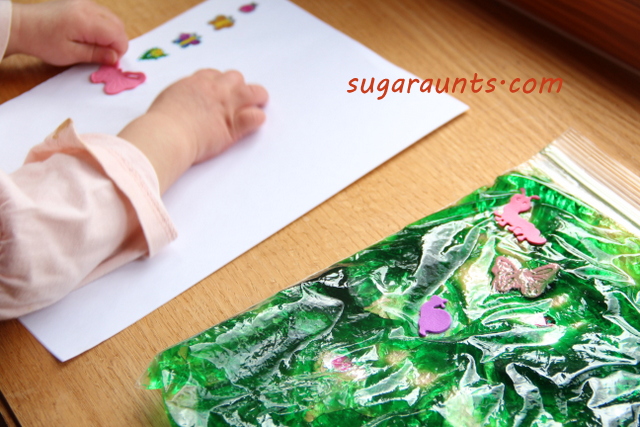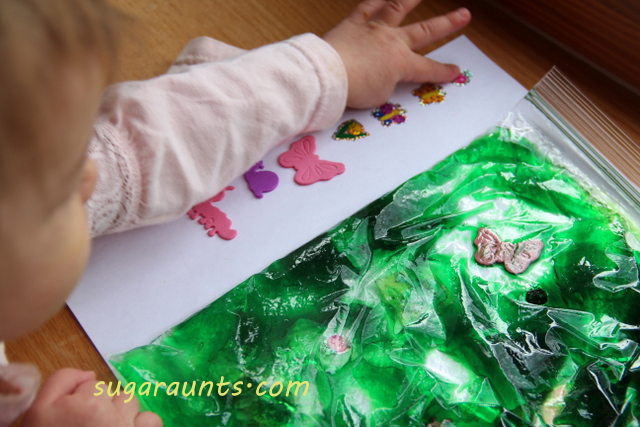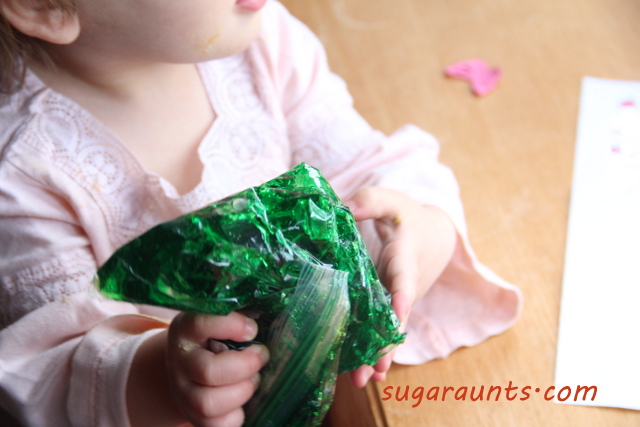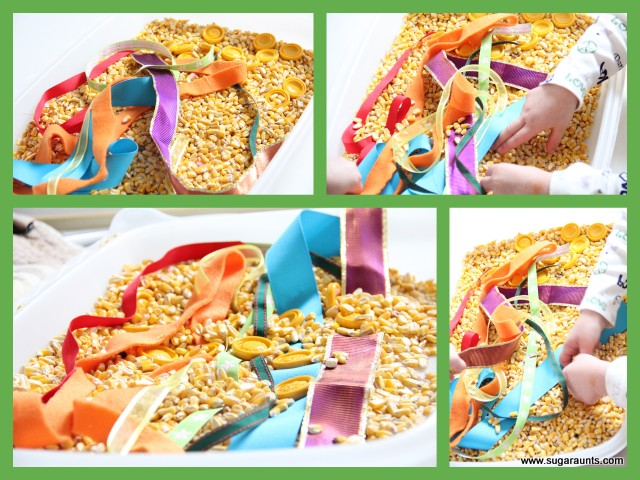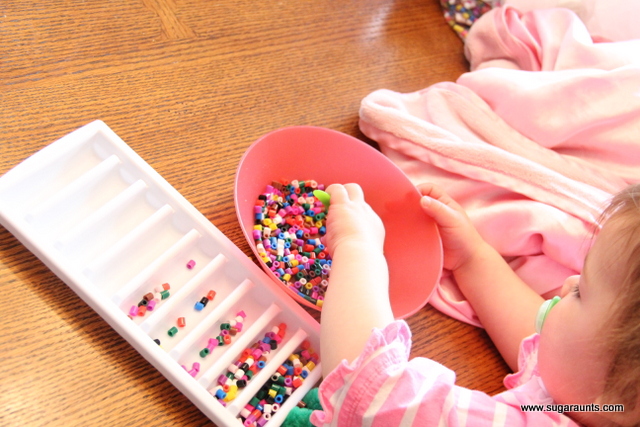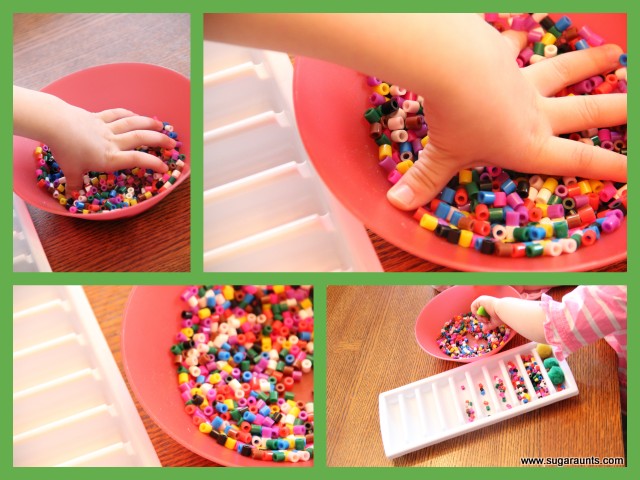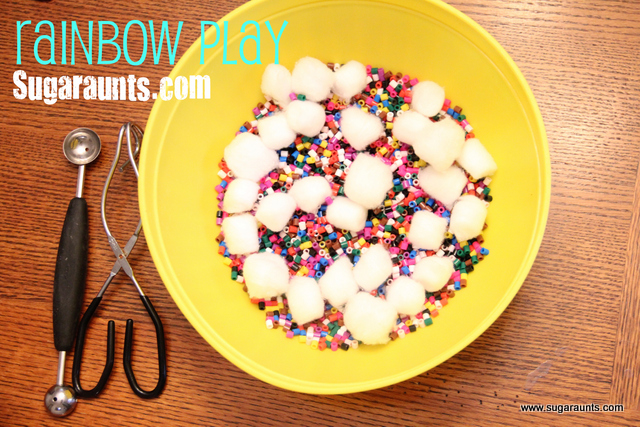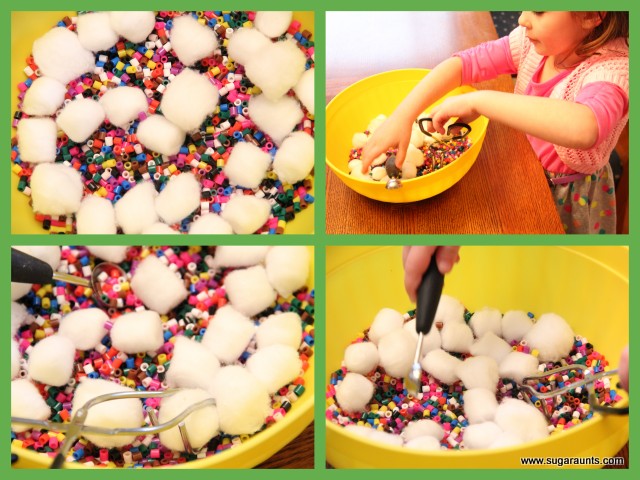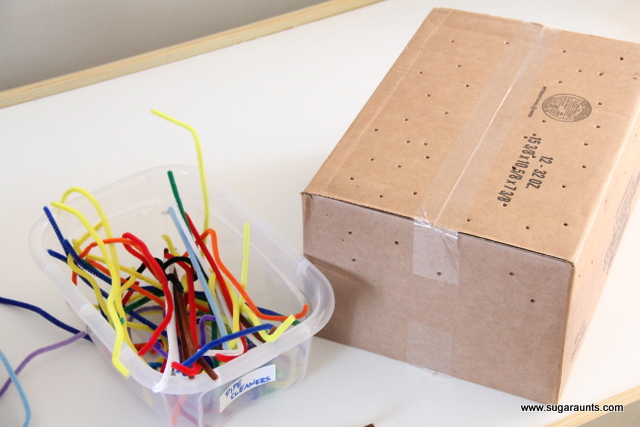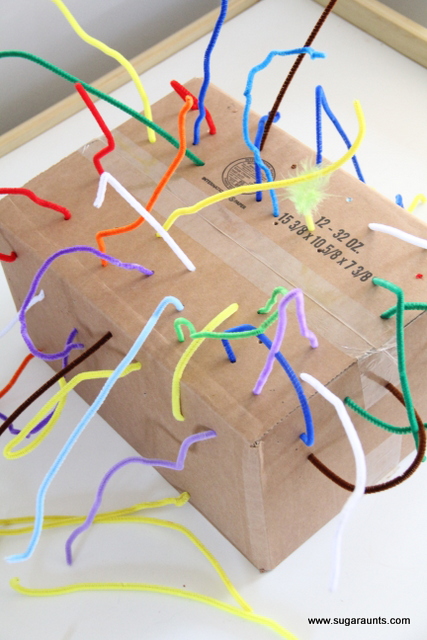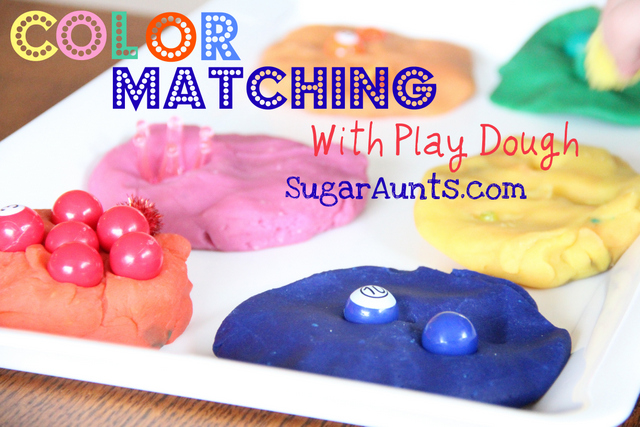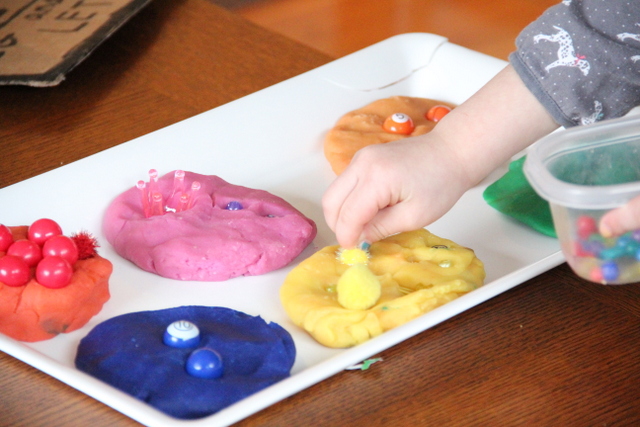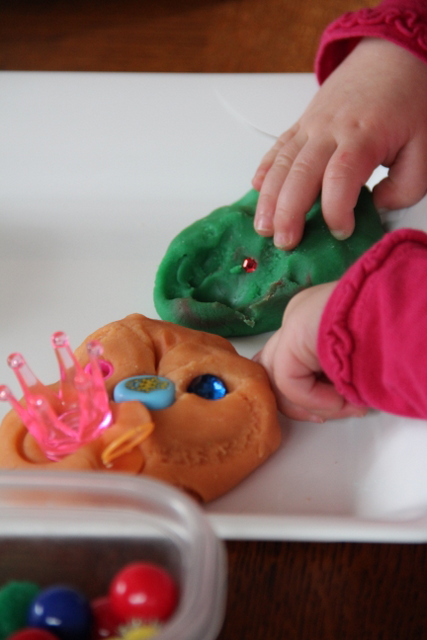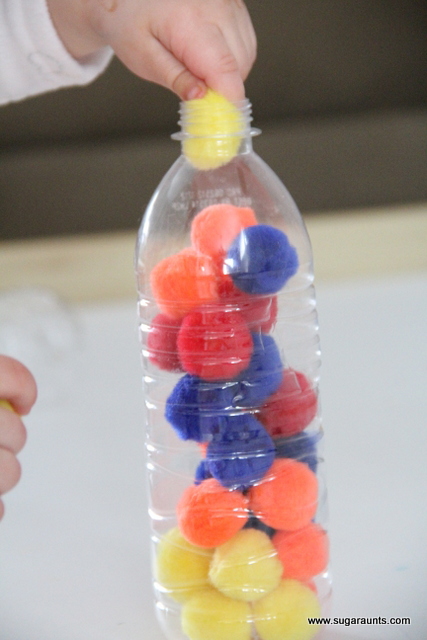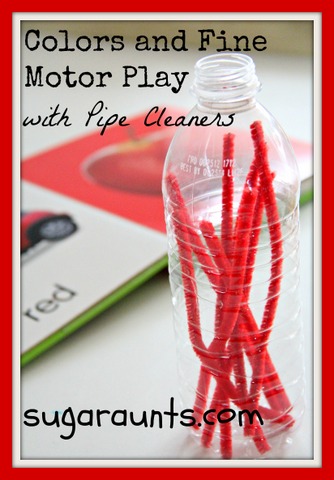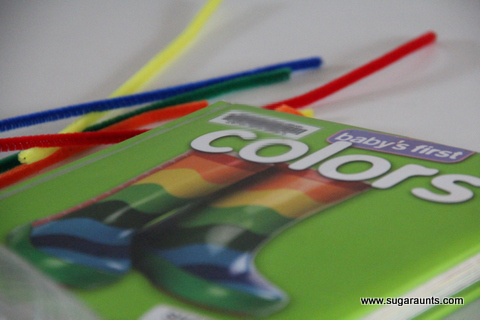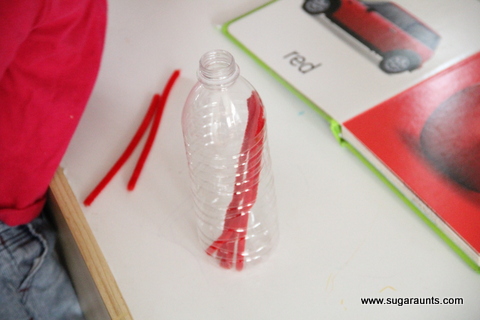fine motor skills
Spring Play Dough Press
Spring Play Dough: Exploring Imprints
Pre-Handwriting Exercise
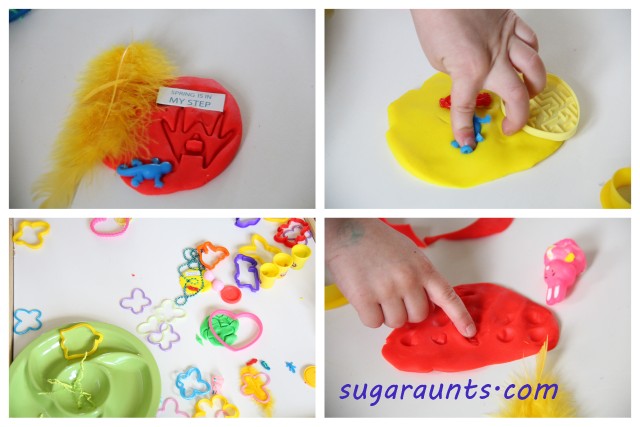
Spring Sensory Seek and Find

Our no-mess sensory play activity was another version of a mess-free indoor sensory play activity.
Spring Seek and Find
- gallon sized baggie
- gel
- food coloring
- Paper
- Stickers- we used Spring stickers
- Today we used some spring flowers that we had and stuck them inside a plastic bag.
- We filled it with aloe gel and some food coloring.
- There were matching stickers on a piece of paper so the kids had to seek and find the match.
Why make a Spring Seek and Find Sensory Bag?
Spring is a great time to get outside and explore the natural world with your senses. You can create your own spring sensory bags by filling them with different materials that will stimulate your senses, such as flower petals, leaves, or even some freshly cut grass.
These sensory bags can be a great way to encourage children to explore their surroundings and discover new things. You could also create a seek and find spring activity, where children have to search for certain items using their senses.
If you have a child who is a sensory seeker, creating a spring sensory bag could be a great way to provide them with the tactile and visual sensory input they crave.
The different textures of the materials inside the bag can help to regulate their sensory system and provide a calming effect. Pressing the bag through the fingers offers calming proprioceptive input through the joints of the hands.
Additionally, creating a spring look and find activity could be a fun way to engage them and provide them with an opportunity to explore their surroundings in a meaningful way.
Spring Sensory Bags
For an I spy sensory bag activity, you could fill a bag with various small objects, such as buttons or beads, and have children search for specific items using their senses.
This activity can be a fun way to develop children’s sensory skills and provide them with a fun and engaging learning experience.
Whether you’re looking to engage your senses or seek out new spring adventures, there are plenty of creative ways to make the most of this vibrant season. So why not grab a seek bag and get started today?
Spring Fine Motor Kit
Score Fine Motor Tools and resources and help kids build the skills they need to thrive!
Developing hand strength, dexterity, dexterity, precision skills, and eye-hand coordination skills that kids need for holding and writing with a pencil, coloring, and manipulating small objects in every day task doesn’t need to be difficult. The Spring Fine Motor Kit includes 100 pages of fine motor activities, worksheets, crafts, and more:
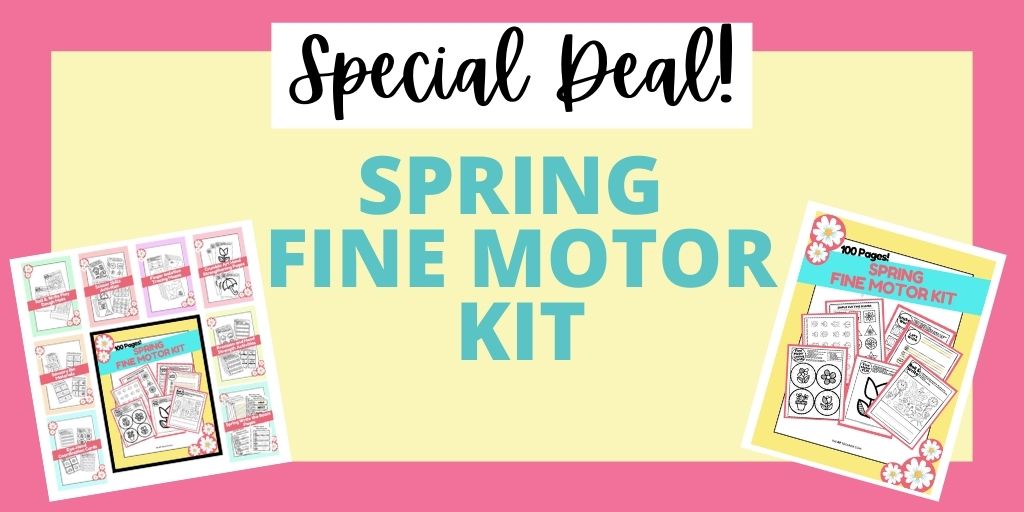
- Lacing cards
- Sensory bin cards
- Hole punch activities
- Pencil control worksheets
- Play dough mats
- Write the Room cards
- Modified paper
- Sticker activities
- MUCH MORE
Click here to add this resource set to your therapy toolbox.
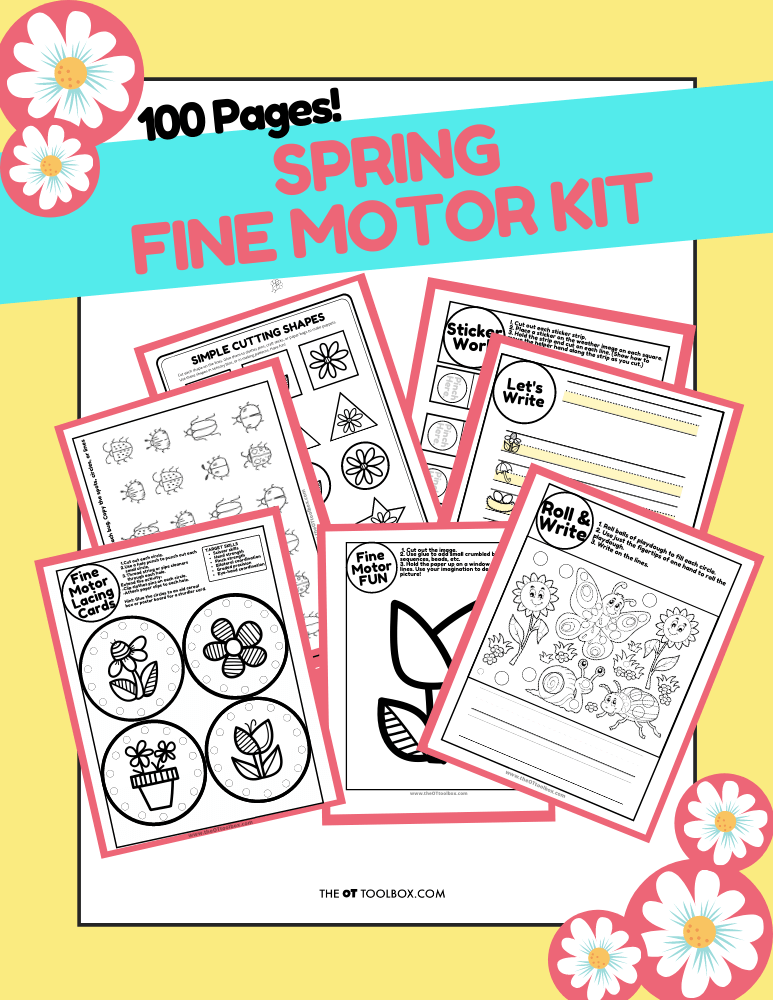
Grab your copy of the Spring Fine Motor Kit and build coordination, strength, and endurance in fun and creative activities. Click here to add this resource set to your therapy toolbox.

Colleen Beck, OTR/L has been an occupational therapist since 2000, working in school-based, hand therapy, outpatient peds, EI, and SNF. Colleen created The OT Toolbox to inspire therapists, teachers, and parents with easy and fun tools to help children thrive. Read her story about going from an OT making $3/hour (after paying for kids’ childcare) to a full-time OT resource creator for millions of readers. Want to collaborate? Send an email to contact@theottoolbox.com.
3 Rainbow Sensory Bins
Kids LOVE rainbow sensory bins! These rainbow sensory bin ideas are some of our absolute favorite sensory bins, and they are the perfect addition to our rainbow activities, rainbow crafts, and a rainbow theme in therapy. Be sure to use our rainbow breathing exercise, too. Let’s talk rainbow sensory play!
Rainbow sensory bins
A sensory bin is a container filled with materials that are designed to engage children’s senses and encourage exploration and play. They can be as easy or as complicated as you like, but the concept is the same- sensory based, tactile play with a theme or play idea with items to manipulate and explore as the user explores their tactile sensory system.
These materials can include a wide range of sensory inputs such as sand, rice, beans, water, or small objects like toys, beads, and stones. Here are many sensory bin base ideas to get you started.
The goal of a sensory bin is to provide children with an opportunity to explore their senses through play. As they play with the materials, they can feel the different textures, see the different colors, and hear the different sounds they make. This can help to promote their sensory development and stimulate their curiosity and creativity.
Sensory bins are often used in early childhood education and therapy settings as a tool for sensory integration therapy, which aims to help children develop and organize their sensory systems. They can also be used at home as a fun and engaging activity for children to play and explore.
We’ve been playing with a rainbow theme alllll week around here. These are three rainbow sensory bins that we have been exploring.
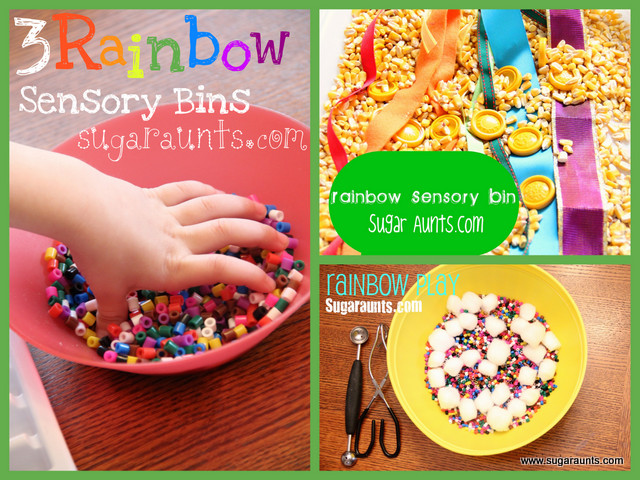

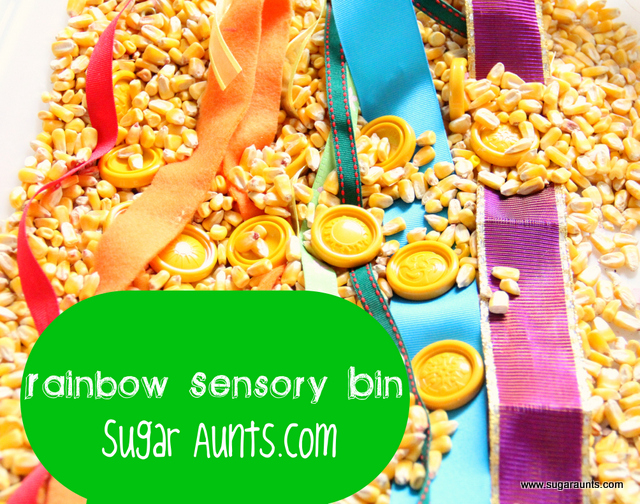

Any time that I pull out the corn bin, everyone gets very excited. I added ribbons in different colors and some “gold coins” (aka yellow Connect Four game pieces!)
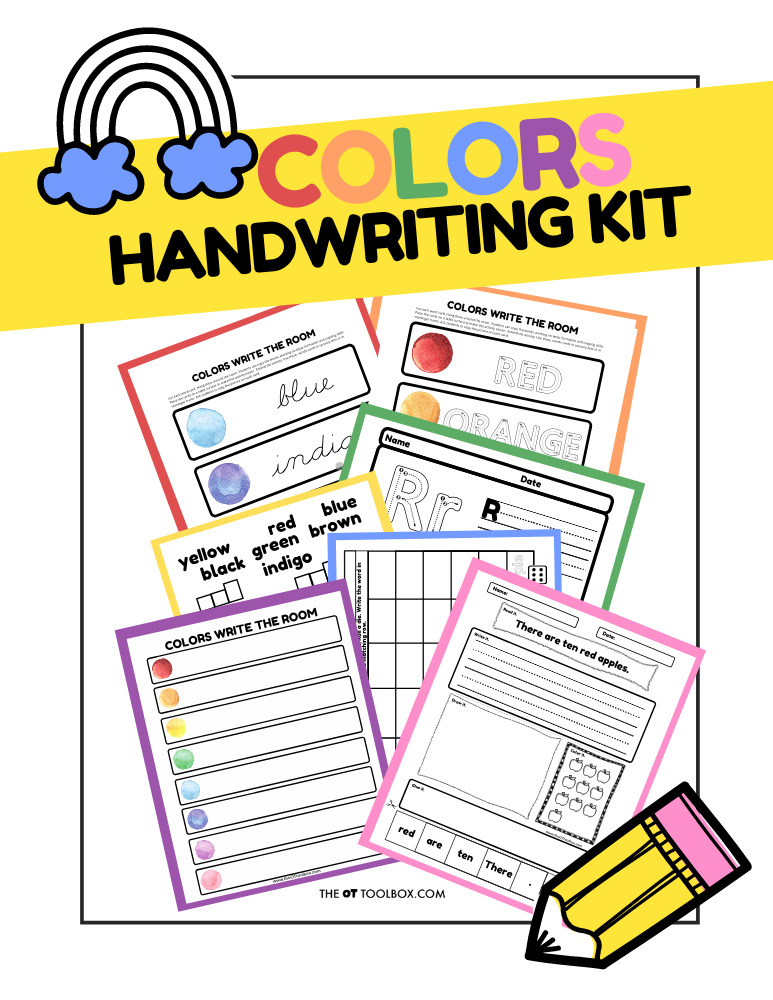

Rainbow Handwriting Kit– This resource pack includes handwriting sheets, write the room cards, color worksheets, visual motor activities, and so much more. The handwriting kit includes:
- Write the Room, Color Names: Lowercase Letters
- Write the Room, Color Names: Uppercase Letters
- Write the Room, Color Names: Cursive Writing
- Copy/Draw/Color/Cut Color Worksheets
- Colors Roll & Write Page
- Color Names Letter Size Puzzle Pages
- Flip and Fill A-Z Letter Pages
- Colors Pre-Writing Lines Pencil Control Mazes
- This handwriting kit now includes a bonus pack of pencil control worksheets, 1-10 fine motor clip cards, visual discrimination maze for directionality, handwriting sheets, and working memory/direction following sheet! Valued at $5, this bonus kit triples the goal areas you can work on in each therapy session or home program.




Colleen Beck, OTR/L has been an occupational therapist since 2000, working in school-based, hand therapy, outpatient peds, EI, and SNF. Colleen created The OT Toolbox to inspire therapists, teachers, and parents with easy and fun tools to help children thrive. Read her story about going from an OT making $3/hour (after paying for kids’ childcare) to a full-time OT resource creator for millions of readers. Want to collaborate? Send an email to contact@theottoolbox.com.
Pipe Cleaner Fine Motor Activity With a Cardboard Box
This pipe cleaner fine motor activity is a fun one that we used for many years to target fine motor skills like dexterity, pincer grasp, hand strength, and more. Plus, this pipe cleaner activity is great for toddlers. But, kids of all ages love this activity! Let’s break it down…
Pipe Cleaner Fine Motor Activity
This fine motor pipe cleaner activity is very simple to set up. You need just two items:
- Pipe cleaners cut into half or one thirds
- A cardboard box
To set up the activity, first cut the pipe cleaners into smaller sections. For younger children use longer lengths of pipe cleaners and for older kids, target more precise fine motor skills but cutting smaller sections.
Then, use a screwdriver and poke holes all over the cardboard box.
You’ll want to poke holes on the top of the box, but also on the sides of the box. A larger box is best for this activity, because the holes on the sides of the box encourages a wider range of motion, including wrist extension.
You’ll also see more diverse movements when a larger cardboard box is used: bilateral coordination, visual scanning, crossing midline, and more.
Another pipe cleaner fine motor activity to try is dropping pipe cleaners into a bottle. Toddlers love that activity, too!
Working on fine motor skills, visual perception, visual motor skills, sensory tolerance, handwriting, or scissor skills? Our Fine Motor Kits cover all of these areas and more.
Check out the seasonal Fine Motor Kits that kids love:












Or, grab one of our themed Fine Motor Kits to target skills with fun themes:
- Frogs Fine Motor Kit
- Unicorns Fine Motor Kit
- Vehicles Fine Motor Kit
- Apple Fine Motor Kit
- Back to School Kit
- Sports Fine Motor Kit
- Outer Space Fine Motor Kit
- Fairytale Fine Motor Kit
- Plus more in our shop!
Want access to all of these kits…and more being added each month? Join The OT Toolbox Member’s Club!




Colleen Beck, OTR/L has been an occupational therapist since 2000, working in school-based, hand therapy, outpatient peds, EI, and SNF. Colleen created The OT Toolbox to inspire therapists, teachers, and parents with easy and fun tools to help children thrive. Read her story about going from an OT making $3/hour (after paying for kids’ childcare) to a full-time OT resource creator for millions of readers. Want to collaborate? Send an email to contact@theottoolbox.com.
Color Matching With Play Dough
Fine Motor Strengthening for kids
Fine Motor Play with crafting pom poms
Fine motor play for toddlers is a win in our house. Toddlers seem to love moving, scooping, dropping, and sorting items, so why not incorporate fine motor skills into the activity?
Looking for more creative ideas for toddlers? Try these ones.
Fine Motor Work for Toddlers and Preschoolers
Color Sorting for Preschoolers
Bilateral Coordination for Toddlers
Bilateral coordination for toddlers is part of development and this plastic bottle and craft pom pom activity is a great tool to support this sensory motor skill.
MORE Fine motor activities your child will LOVE:


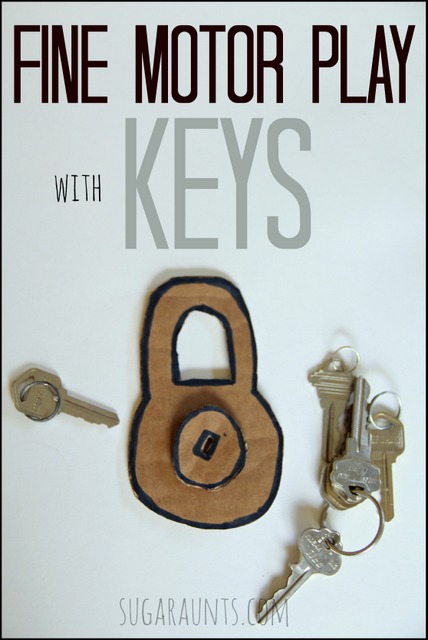

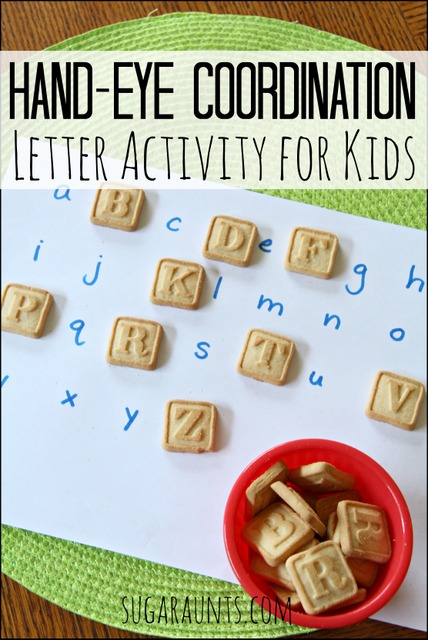



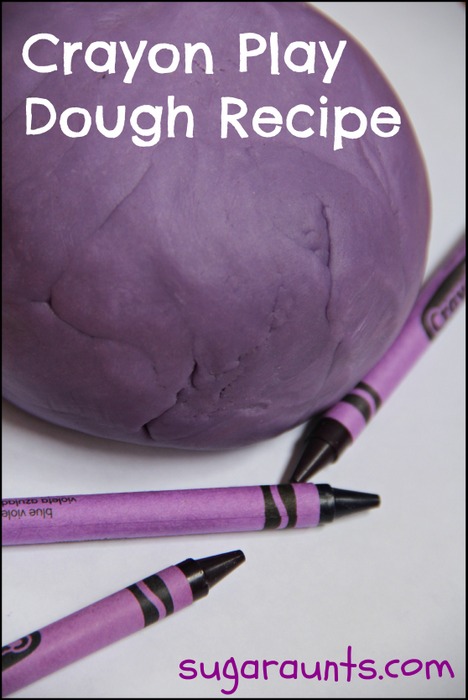

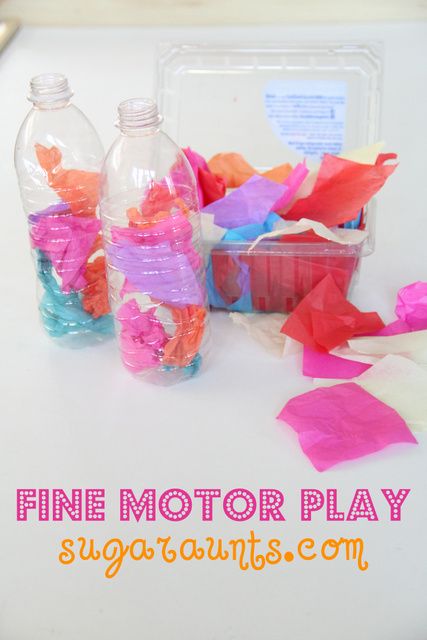

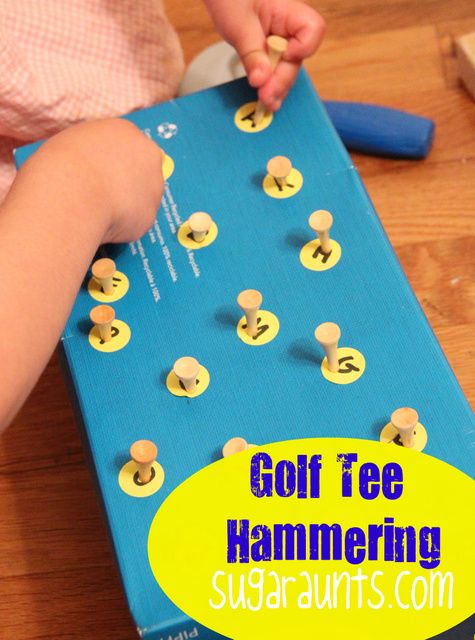

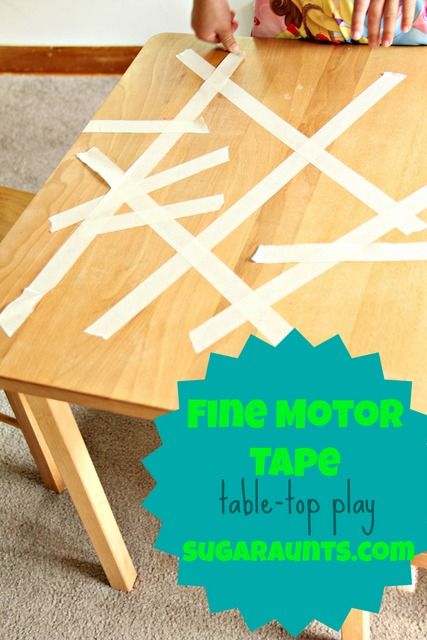

Pipe Cleaner Fun
Try this fine motor activity that uses a simple item you probably already have in the house right now: a plastic water bottle. Add a few pipe cleaners for a fun activity that boosts skills like fine motor skills, visual motor skills, bilateral coordination, and more.
Fine Motor Skills and Learning Colors with Pipe Cleaners
The babies had fun doing a little fine motor activity to go along with the Red page in the book.
I cut some red pipe cleaners in half and put out an empty water bottle.
This is great for a Toddler’s Fine Motor Skills, Eye-Hand Coordination, and Cause-Effect.
Using Stickers to Help with Scissor Skills
There are so many fun ways to use stickers for fine motor skill development.


(and also because we have millions of them)
What else can you do with stickers when practicing cutting…
Colleen



